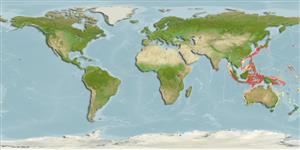Environment: milieu / climate zone / depth range / distribution range
البيئة
بحري قاعية المعيشة; نطاق العمق 200 - 500 m (Ref. 9771). Deep-water
Indo-Western Pacific: Philippines, Japan and Indonesia.
الحجم / وزن / العمر
Maturity: Lm ? range ? - ? cm
Max length : 9.0 cm TL ذكر/ مختلط الجنس; (Ref. 559)
وصف مختصر
الوصف الخارجي | قياسات المظهر الخارجي
الأشواك الظهرية (المجموع): 6 - 8; الأشعة الظهرية الناعمة (المجموع): 18-21; أشعه شرجية لينه: 18 - 19. This species is characterized by the following: fusiform body covered with bony plates with head large and depressed; broad snout, with short, triangular rostral projection on each side, nearly parallel to each other; interorbital region concave and with no distinct ridges; head with supraocular, parietal, posttemporal, opercular, and preopercular spines; large and inferior mouth with posterior tip of upper jaw reaching point below anterior border of orbit; upper jaw with villiform teeth; no teeth on lower jaw, vomer and palatine; 1-2 short barbels on lip, none on chin; body plates arranged in 4 rows, each plate with single, posteriorly directed spine; plates in upper lateral row lack anteriorly directed spine; anterior 4 (or 5) plates small; lower lateral row of bony plates ending at caudal peduncle and separated from the other side; 4 (or 5) plates along ventral region anterior to anus, with the most anterior largest; dorsal fin origin between first and second bony plates in dorsal row, ending on anterior part of caudal peduncle; anal fin origin just posterior to anus, also terminating on anterior part of caudal peduncle; pectoral fin reaching posteriorly to near anus length; 2 ventralmost pectoral fin rays detached, large and thickened; pelvic fin reach posteriorly to point between origin of dorsal and anus fins; when fresh, colour of head and dorsal part of body pale red, ventral part of body whitish; dorsal part with yellowish-green spots; fins mostly whitish; 2 dusky bands on pectoral fin (Ref. 93670).
Deep benthic species of limited commercial value inhabiting warm tropical seas along continental shelf edge and slope. Bony scutes reduce commercial value (Ref. 9771).
Life cycle and mating behavior
النضج | التكاثر | وضع البيض | بيض | الخصوبة | Larvae
Richards, W.J., 1999. Triglidae. Gurnards, sea robins, armored gurnards, and armored sea robins. p. 2359-2363. In K.E. Carpenter and V.H. Niem (eds.) FAO species identification guide for fishery purposes. The living marine resources of the WCP. Vol. 4. Bony fishes part 2 (Mugilidae to Carangidae). FAO, Rome. (Ref. 9771)
IUCN Red List Status (Ref. 130435)
استخدامات بشرية
مصائد: غير ذات اهمية
مزيد من المعلومات
الأسماء الشائعةمرادفاتالأيضمفتريساتعلم السميات البيئيةالتكاثرالنضجوضع البيضتجمعات وضع البيضالخصوبةبيضتطور البيضة
العمر/ الحجمنموالطول-الوزنالطول-الطولالطول- التردداتقياسات المظهر الخارجيالوصف الخارجيLarvaeحركة انتقال اليرقاتتوظيفالوفرةBRUVS
مراجعالأستزراع المائيملف الأستزراع المائيسلالاتجينيElectrophoresesالتوريثالأمراضمعالجةNutrientsMass conversion
المتعاونينصورStamps, Coins Misc.اصواتالتسمم باكل السمكسرعةنوع السباحةمنطقة الخياشيمعظمة الأذندماغرؤية
أدوات
تقارير خاصة
Download XML
مصادر علي الأنترنت
Estimates based on models
Preferred temperature (Ref.
123201): 11.1 - 13.7, mean 12.5 °C (based on 30 cells).
Phylogenetic diversity index (Ref.
82804): PD
50 = 1.0000 [Uniqueness, from 0.5 = low to 2.0 = high].
Bayesian length-weight: a=0.00646 (0.00304 - 0.01372), b=3.08 (2.90 - 3.26), in cm total length, based on LWR estimates for this (Sub)family-body shape (Ref.
93245).
مستوى غذائي (Ref.
69278): 3.3 ±0.3 se; based on size and trophs of closest relatives
المرونه (Ref.
120179): عالي, الحد الزمني الأدني لتضاعف عدد أفراد المجتمع أقل من 15 شهر (Preliminary K or Fecundity.).
Fishing Vulnerability (Ref.
59153): Low vulnerability (10 of 100).
